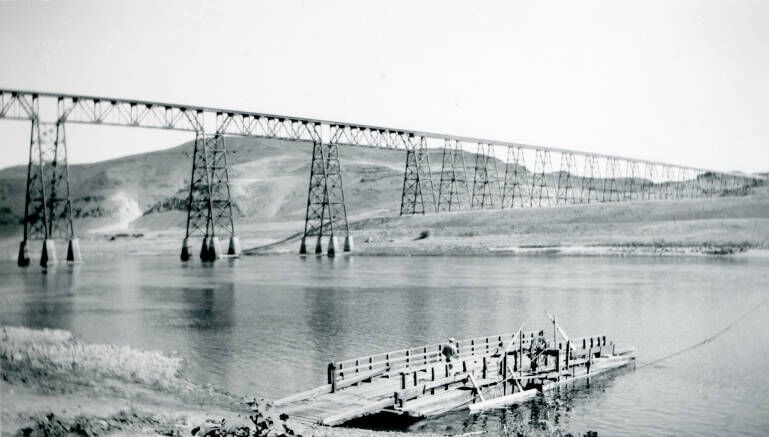forum
library
tutorial
contact

Nearby History: Lyons Ferry and Life
Before Dams, Bridges on the Lower Snake
by Kathryn Meyer
Moscow-Pullman Daily News, October 28, 2023
|
the film forum library tutorial contact |

|
Nearby History: Lyons Ferry and Life
by Kathryn Meyer
|
Ferry service ended altogether when
Lower Monumental Dam was completed in 1969.
 Before the lower Snake River dams were built in the 1960s, its waters could be fast, dangerous and difficult to ford. Indigenous peoples used canoes and rafts, but crossing was often impossible, especially in winter. After the arrival of white settlers in the mid-1800s, however, multiple ferries began operating on the Snake between Clarkston and Lyons Ferry. Most were cable ferries, which were guided using ropes, chains or heavy wire anchored on both banks.
Before the lower Snake River dams were built in the 1960s, its waters could be fast, dangerous and difficult to ford. Indigenous peoples used canoes and rafts, but crossing was often impossible, especially in winter. After the arrival of white settlers in the mid-1800s, however, multiple ferries began operating on the Snake between Clarkston and Lyons Ferry. Most were cable ferries, which were guided using ropes, chains or heavy wire anchored on both banks.
The first was the Palouse Ferry, later called Lyons Ferry, which was located near the convergence of the future counties of Whitman, Columbia and Franklin at the confluence of the Snake and Palouse Rivers.
It carried mostly local passengers across 1,200 feet of water for 108 years.
It was originally owned by the "McVick Brothers" and subsequently by Edward Massy, who moved it a few miles upriver. It was operating commercially in the late 1850s, but without the sanction of the Washington Territorial government.
The following year, the ferry was authorized by the Eighth Regular Session of the Legislative Assembly in Olympia, when it enacted the Snake River Ferry Act of 1860. It provided a vital crossing over the Snake on the Mullan Road -- the first wagon road to cross the Rockies and enter the Inland Pacific Northwest. It connected Fort Benton (in what later became Montana) and Walla Walla.
Daniel Lyons and John Markley purchased the ferry in the 1870s or 1880s. Daniel and his wife Olive also owned a large horse ranch near the crossing on the Columbia County side. In addition to passage across the river, they offered travelers hot food, fresh horses, and livestock feed. When Daniel died in 1893, Olive took over the ranch and the ferry. She was assisted by Everett Truit, who was 30 years her junior and boarded with her. She sold her interest in the ferry in 1926, a year before her death at 82. The new owner, W.C. Cummings, renamed it Lyons Ferry in honor of the family that had operated it for nearly 50 years.
Cummings eventually sold the ferry to Ervin Ritter, who sold it to Nate and Ruth Turner in 1945. The couple immediately decided to replace the aging ferry, which had been powered by steam and guided by cable -- and could only hold three cars. The new ferry, designed by Nate, took four years to build. It was twice as big as the old one and ran on cable only. When launched, it immediately sank to the river bottom due to the weight of the creosote that coated its exterior; but after it was raised and pumped out, it never sank again.
Like the Lyons, the Turners offered exceptional service to travelers. If people on either side needed to cross, they honked their horns and, no matter the hour, the Turners would arise and take them across. In the fall, hunters began forming lines at 3 a.m. The Turners also ferried numerous herds of sheep, charging 1 cent per head. The ferry could hold 150 sheep per trip. It could cross the river in anywhere from 3 to 20 minutes, depending on the current and weather.
Lyons Ferry was particularly important while the U.S. Corps of Engineers was building nearby Little Goose Dam in the late 1960s. It operated around the clock to carry equipment and material to the road to the construction site. Not long after the dam's completion, the Coast Guard limited the ferry's operation to daylight hours.
Ferry service ended altogether when Lower Monumental Dam was completed in 1969. Rising water in the new manmade lake had increased the crossing distance and time. Loss of most of the river's current was also a problem. Finally, increased traffic and the ferry's small size resulted in the state's decision to build a bridge.
Providentially, the Wanapum Dam (downstream from Vantage on the Columbia River) had been completed a few years earlier. The old Vantage Ferry Bridge, built in 1927, had been dismantled and stored. The state rebuilt it near the site of the Lyons Ferry crossing. The cost was a mere $976,261 ($8.6 million in today's purchasing power).
When the bridge officially opened on Dec. 26, 1968, Lyons Ferry made its last trip across the Snake. It had been the longest continuously operated cable ferry west of the Rockies.
learn more on topics covered in the film
see the video
read the script
learn the songs
discussion forum
